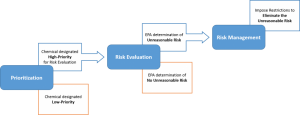This website uses cookies so that we can provide you with the best user experience possible. Cookie information is stored in your browser and performs functions such as recognising you when you return to our website and helping our team to understand which sections of the website you find most interesting and useful.
News
EPA Details New Oversight of Chemicals Under d TSCA
The Environmental Protection Agency has published final rules establishing a strategy to evaluate and regulate chemicals in commerce as required under the updated Toxic Substances Control Act (TSCA). TSCA was amended last year through passage of the Frank R. Lautenberg Chemical Safety for the 21st Century Act (LCSA). The law requires EPA to reduce exposure to persistent, bioaccumulative, and toxic (PBT) chemicals.
Under LCSA, EPA is required to draft scoping documents for each chemical it plans to review. This will include the hazard(s), exposure(s), conditions of use, and the potentially exposed or susceptible subpopulation(s) the agency plans to consider for the evaluation.
The agency also released guidance to help companies, trade associations, or other non-agency parties submit draft chemical risk evaluations for the EPA’s consideration.
“The new process for evaluating existing chemicals outlined in these rules will increase public confidence in chemical safety without stifling innovation,” said EPA Administrator Scott Pruitt.
Three Final Rules
The three final rules outline the procedures under which EPA will:
- determine which chemicals have actively been in commerce over the last 10 years;
- select chemicals as high or low priorities for risk evaluation; and
- set out how the EPA will evaluate the risks of high-priority chemicals.
Inventory Reset Rule
The inventory reset rule (RIN:2070-AK24) requires chemical manufacturers and importers to notify EPA of compounds they’ve made, imported, or processed over the last 10 years. LCSA requires EPA to designate chemical substances on the TSCA Chemical Substance Inventory as either “active” or “inactive” in U.S. commerce. The information is then used by EPA to identify which chemicals on the TSCA Inventory are still active in U.S. commerce and will help inform the prioritization of chemicals for risk evaluation.
The EPA said it responded to comments on its proposed rule by streamlining the reporting requirements for manufacturers and processors to make notification easier.
Revised Prioritization Rule
The prioritization rule (RIN:2070-AK23) establishes a screening process through which EPA will determine which chemicals pose enough potential harm to designate them a high priority for risk evaluation. The rule also describes how the agency will use its screening process to determine which chemicals have enough information to designate them as low priorities for risk evaluation.
EPA will also provide two public comment periods as chemicals are evaluated under the prioritization process.
Chemical Prioritization Process


Risk Evaluation Rule
The risk evaluation rule (RIN:2070-AK20), describes how EPA will determine whether a chemical substance presents an unreasonable risk to health or the environment, under the conditions of use. The agency must evaluate both hazard and exposure while excluding consideration of cost and other non-risk factors. The rule also defines terms like “best available science” and “weight of the scientific evidence,” upon which EPA regulatory action must be based. The risk evaluation rule also notes that EPA does not have to consider all conditions of use, noting its authority to focus on chemicals with the greatest potential harm.
Risk Evaluation Process and Timeline


If you’d like more information of implementation of the LCSA, please contact the VI at jserrano@vinylinfo.org.


